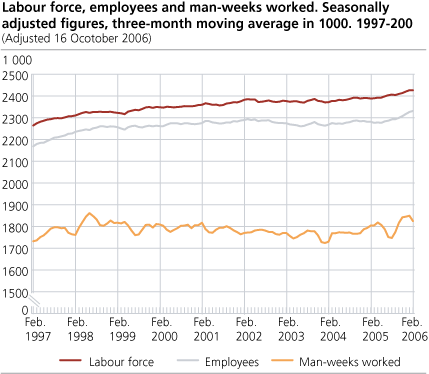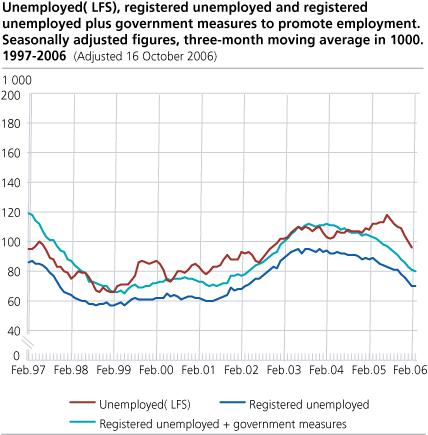Content
Published:
This is an archived release.
22 000 more temporary employed
The number of employees increased by 50 000 from Q1 2005 to Q1 2006, where the temporary employed went up by 22 000. The figures are taken from the latest Labour Force Survey (LFS) carried out by Statistics Norway. All figures related to unemployment are corrected from what was published 12.05.2006 10:00.
|
Error in unemployment figures for 2006
At the time of the transition to a new LFS questionnaire in January 2006, an error occurred in the data file. Therefore, people who had already accepted a job offer, where the job start was not due until later, have wrongly been defined as outside the labour force, instead of unemployed.
|
|
Seasonally adjusted figures: Employment up and less unemployment
The number of employees rose, while unemployment went down, from the fourth quarter of 2005 to the first quarter of 2006, according to seasonally adjusted figures from the LFS. This is consistent with the development since the summer of 2005. The seasonal adjustment method is a favourable method of revealing the current development in the labour market, and serves as an alternative to comparisons with the corresponding quarter in the previous year. Seasonally adjusted figures are presented in a separate article . |
The temporary employees represented 9.8 per cent of all employees, compared with 8.9 per cent the first quarter of 2005. Especially the use of substitutes contributed the most to the rise in temporary employment, but also the number of apprentices/trainees showed some increase from the first quarter of 2005. While the primary and secondary industries showed decline in the share of temporary employment, there were with almost no exceptions increase in all the service related industries. Especially transport and communication, education and health and social work showed significant growth. Temporary employment was most common in the two last mentioned industry divisions (16 per cent of all employees). At the opposite end of the scale, manufacturing (4.6 per cent) and construction (5.7 per cent) are characterised by relatively few temporary employees.
In total, employment went up by 50 000 people from the first quarter of 2005 to the first quarter of 2006. The industries with the strongest increase were financial intermediation and business activities, in addition to health and social work.
Increased labour force participation
Total labour force participation went up by 0.3 percentage points from the first quarter of 2005 to the first quarter of 2006. Both men and women experienced an increase. Apart from people under 20 years, there were growth in all age groups.
Unemployment down 12 000
The number of unemployed people in the first quarter of 2006 went down by 12 000 from the first quarter of 2005. Men aged 16-24 and 25-54 years showed the strongest decline. The total unemployment rate was 3.9 per cent, the rate for men 4.1 per cent and the rate for women 3.8 per cent. The proportion of long-term unemployed was 33 per cent in the first quarter of 2006, up 9 percentage points from the first quarter of 2005. Long-term unemployment is defined as unemployment that has lasted for at least six consecutive months.
114 000 underemployed
The number of underemployed, i.e. part-time employees who want to work more hours, was 114 000 in the first quarter of 2006, approximately unchanged from the first quarter of 2005.
The underemployed represent 17.7 per cent of all part-time employees, compared with 17.6 per cent in the first quarter of 2005. The majority of the underemployed work in health and social work or retail trade. Half of all part-time employees work in these two sectors.
Actual hours worked for the unemployed and underemployed amounted to 121 000 man-weeks (full-time work) in the first quarter of 2006 - 10 000 less than in the first quarter 2005.
Unemployment down in Germany
The seasonally adjusted unemployment rate for Norway was 4.0 per cent in February 2006, compared with 4.5 per cent in November 2005. The rate in the EU15 area remained unchanged at 7.7 per cent, but fell in the OECD area from 6.5 to 6.3 per cent. In the same period, unemployment fell from 5.0 to 4.8 per cent in the USA. In Denmark, the rate increased from 4.1 to 4.4 per cent, while Finland had a decline from 8.3 to 8.1 per cent. From November to February, unemployment fell from 9.3 to 9.1 per cent in France, and from 9.3 to 8.9 per cent in Germany, according to figures from the OECD and Eurostat .
Changes in the LFS from 2006
With effect from January 2006, some improvements have been made in the Norwegian LFS. This will make the employment and unemployment figures more comparable with figures from the EU-countries. In addition, actual working hours will be measured more accurately. Therefore, the changes have lead to a level shift in the LFS figures. Much of the shift can be adjusted for in the figures, and therefore, we have made to sets of figures for the first quarter of 2006 in the various tables. In the text above, the figure changes (from the same quarter last year) refer to the set containing the figures according to the LFS prior to the changes. For more details on the LFS, the seasonal adjustment method and the changes in the LFS, you can click on the links at the left side of this page.
(1) The figures for underemployment in 2006 are incorrect. More information is available here .
Tables:
- Table 1 Population aged 15-74(1) in the labour force, man-weeks worked, unemployed (LFS)(6), registered unemployed persons and persons employed by government measures (Aetat). 1000 and per cent
- Table 2 Population aged 16-74(1) år in the labour force, employed persons and unemployed persons by sex (LFS)(3). 1000 and per cent
- Table 3 Persons in the labour force and employed persons aged 15-74 by age 1) and sex (LFS) 3). 1 000 and per cent
- Table 4 Population aged 15-74(1), employed persons by settled/usual working hours per week(2) and unemployed persons by age and sex (LFS)(3,4). 1000
- Table 5 Persons in the labour force aged 15-74 by age(1,2) and sex (3). 1000 and as per cent of all in each group
- Table 6 Employed persons aged 15-74 3) by sex and settled/usual working hours pr week (LFS). 1 000
- Table 7 Population aged 15-741,2 by main activity, part-time employment3 and age (LFS). 1 000
- Table 8 Employed persons aged 15-74(1) by major industry division (LFS)(2). 1000
- Table 9 Number of man-weeks worked1 2, by industry division (LFS)3. 1 000
- Table 10 Employed persons aged 15-743, total, and employed persons at work by status and sex. Number of man-weeks worked 1and actual working hours per week (LFS)
- Table 11 Employed persons aged 15-74(1) and absence from work(2) during the whole reference week by reason for absence and sex (LFS)(3). 1000 and per cent
- Table 12 Employees aged 15-74(1,2) with temporary jobs, by major industry division (LFS). 1000 and as per cent of all employees
- Table 13 Unemployed persons aged 15-74(1) by sex and age (LFS)(2,3). 1000 and per cent
- Table 14 Unemployed persons aged 15-74(1) by duration of job search (LFS)(2,3). 1000 and per cent
- Table 15 Unemployed persons aged 15-74 1) by main activity 2 4 (LFS). 1 000
- Table 16 Unemployed and underemployed persons aged 15-74(1,2), by sex and desired working hours per week. Number of man-weeks (of 37,5 hours) supplied (LFS). 1000
- Table 18 Persons in the labour force by sex and region(LFS). 1 000 and in per cent of total
- Table 19 Employed persons aged 15-74 1) by sex and region 2)(LFS). 1 000
- Table 20 Employed persons aged 15-74 1) by sex and region 2)(LFS). Per cent of all inn each group
- Table 21 Employed persons by some major industry division and region (LFS). 1997-2005. 1000
Contact
-
Arbeidsmarked og lønn
E-mail: arbeidsmarked@ssb.no
-
Erik Herstad Horgen
E-mail: erik.horgen@ssb.no
tel.: (+47) 93 08 68 62
-
Ole Sandvik
E-mail: ole.sandvik@ssb.no
tel.: (+47) 99 04 82 06
-
Håvard Hungnes Lien
E-mail: havard.lien@ssb.no
tel.: (+47) 40 90 26 06


